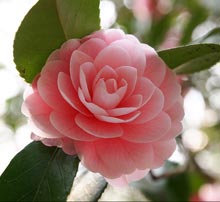 Camellias have always fascinated me. They are blooming when other flowering shrubs are asleep or just waking up. We see them in parks, homes and gardens across the South, and there are International and American Camellia Societies with local and regional chapters. The beautiful flowers are not fragrant but used to be very popular as corsages. It’s probably been 45 years since I wore a corsage, but I was reading my 1968 World Book Encyclopedia and there was a picture of a gorgeous – even in black and white – bloom as a corsage. I have lived in the South all of my life, except two years in college in Northern Virginia, and just assumed Camellias were native here. We are all natives somewhere, and Camellias (by the way the pronunciation is ca-may-lee-ya) originated in China and Japan. They are in the Tea family, and most of us southerners also enjoy that beverage and drink the orange liquid with lots of sweet or not. Recently, in the last 20-40 years or so, people began to notice other teas. Green tea and herbal teas became popular drinks for health and happiness. Green tea is the unfermented version of Camellia senensis leaves and is supposed to have all kinds of great benefits to our hearts, energy, and beauty. We do have a member of the Tea family which is native to southeastern North America growing here in Beaufort County, Stewartia malacodendron, whose moniker is Silky Camellia.
Camellias have always fascinated me. They are blooming when other flowering shrubs are asleep or just waking up. We see them in parks, homes and gardens across the South, and there are International and American Camellia Societies with local and regional chapters. The beautiful flowers are not fragrant but used to be very popular as corsages. It’s probably been 45 years since I wore a corsage, but I was reading my 1968 World Book Encyclopedia and there was a picture of a gorgeous – even in black and white – bloom as a corsage. I have lived in the South all of my life, except two years in college in Northern Virginia, and just assumed Camellias were native here. We are all natives somewhere, and Camellias (by the way the pronunciation is ca-may-lee-ya) originated in China and Japan. They are in the Tea family, and most of us southerners also enjoy that beverage and drink the orange liquid with lots of sweet or not. Recently, in the last 20-40 years or so, people began to notice other teas. Green tea and herbal teas became popular drinks for health and happiness. Green tea is the unfermented version of Camellia senensis leaves and is supposed to have all kinds of great benefits to our hearts, energy, and beauty. We do have a member of the Tea family which is native to southeastern North America growing here in Beaufort County, Stewartia malacodendron, whose moniker is Silky Camellia.
Camellia japonicas were brought to Charleston by wealthy Middletons and Draytons to adorn their formal gardens. Even before I studied and appreciated the horticultural importance of these old shrubs, I was very impressed with the size and beauty of the ones at Middleton Place. There is another great place to visit nearby with a very impressive collection of different species of Camellias. The arboretum at Atlantic Armstrong University in Savannah has many unusual types of shrubs on its large campus, and while there are numerous mature C. japonicas, there are also lovely and uncommon species of Camellia as well. Because they begin to bloom in fall and continue until April, winter is actually a great time to visit.
What do gardeners need to know about the cultural requirements of Camellia? They were found originally growing in China on the side of a mountain, according to J.Weidner. There was lots of organic matter (leaf mold) and perfect drainage. They can reach a height of 15’-25’, with a 6’-10’ spread. Don’t plant them too close to the house or to each other. Temperate climate, understory – plants grown not in full sun but sufficient light, good air flow are all parts of the mix. Leaf size is directly related to the amount of sunlight a camellia will tolerate. The smaller leaves on C. sasanqua enjoy full sun. Large leathery C. japonica leaves will not put up with that intensity. The leaves of C. senensis are relatively small; the shrubs make a very beautiful hedge or accent plants. They are grown commercially on tea plantations in full sun.
Good cultural practices will help to ensure the health and beauty of landscape plants. It is so important to know the requirements of plant families or species. A healthy plant is less likely to suffer disease and insect pressure than one that is stressed. Early detection and rapid response to problems is always preferable. Visit your Camellias often, look on the underside of the leaves, keep them moist but not wet. Give compost and leaf mold generously, pick up and destroy spent blooms, and wear the blooms as corsages or pinned to your favorite hat. This is Camellia season in the South.
Visit the AASU arboretum http://www.armstrong.edu/Departments/Arboretum/arboretum_contact
Clemson Home and Garden website http://www.clemson.edu/extension/hgic/
American Camellia Society http://www.camellias-acs.com/
International Camellia Society http://camellia-ics.org/








